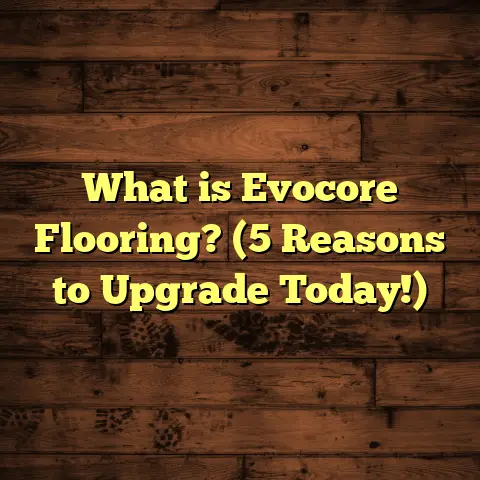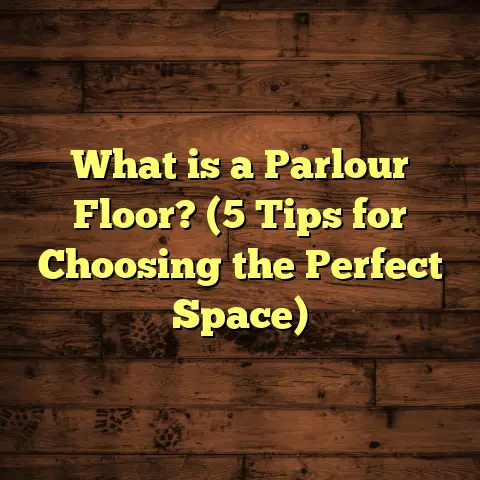What is Cheaper: Wood or Tile Flooring? (5 Key Cost Factors)
Allergies and Flooring: My Personal Take
Living with allergies is no joke. For years, I struggled with sneezing fits, itchy eyes, and congestion that seemed to get worse every time I spent more than a few hours inside my own home. When I finally decided to renovate my floors, I realized how much the choice of flooring impacts indoor air quality. Carpets trap dust mites, pet dander, pollen, and other allergens that can aggravate respiratory issues. If you’re like me and want a home that feels fresh and clean, hard flooring surfaces are the way to go.
But what kind of hard flooring? Wood or tile? I started asking friends, browsing online forums, and consulting with flooring contractors. Each option seemed to have its own pros and cons—some said wood was warmer and more comfortable; others said tile was easier to keep clean. Then there was the price factor. Which option fits better in the budget without sacrificing quality?
I decided to break it down step by step because when allergies and budget collide, you want to be sure you’re making the right choice for your health and wallet.
What Is Cheaper: Wood or Tile Flooring?
This question isn’t as simple as it sounds. “Wood” can mean solid hardwood or engineered hardwood, each with different prices and installation methods. “Tile” usually refers to ceramic or porcelain tiles but could also include natural stone tiles like marble or slate, which are often pricier.
To figure out what’s cheaper overall, I looked into five key cost factors:
- Material costs (what you pay for the flooring itself)
- Installation costs (how much labor adds to the price)
- Durability and maintenance (ongoing costs to keep floors looking good)
- Waste factor (extra materials needed due to cuts and mistakes)
- Environmental and health factors (impact on indoor air quality and comfort)
Let me walk you through each one in detail—complete with real numbers, personal stories, and insights from professionals I chatted with.
1. Material Costs: What You Pay Upfront
When I first started looking at wood flooring options, I was shocked at the range of prices. Solid hardwood like oak or maple typically costs between $5 and $10 per square foot. That might not sound bad until you realize that for a 1,000-square-foot room, that’s $5,000 to $10,000 just for materials. Engineered hardwood is usually cheaper—$3 to $7 per square foot—and offers a similar look but with better moisture resistance.
On the tile side, ceramic tiles are usually less expensive than wood materials, ranging from about $1 to $5 per square foot. Porcelain tile is sturdier and more water-resistant but can cost anywhere from $3 to $10 per square foot.
Here’s something interesting I discovered: natural stone tiles like marble or travertine can be two or three times more expensive than ceramic or porcelain. They require special sealing and maintenance too, so they’re not really in the same budget category as standard wood or tile.
My Experience Buying Materials
I remember going to a big box store and comparing hardwood planks with tile samples. The wood had a warm feel under my fingers but was definitely pricier. On the other hand, the tile samples were cold and hard but came in so many styles that I could almost imagine them fitting any room aesthetic.
What surprised me was how much material prices fluctuate by region. In some areas, hardwood is a local specialty and cheaper; in others, tile is more affordable due to supply chains. I found this out after talking with a flooring supplier who explained that shipping heavy tiles adds to their cost.
Data Point: Price Trends Over Time
According to the National Wood Flooring Association (NWFA), hardwood prices have increased about 15% over the past five years due to rising lumber costs worldwide. Meanwhile, tile prices have remained relatively stable but vary depending on raw materials and import tariffs.
2. Installation Costs: Labor Can Be a Game-Changer
Material cost is only part of the story. Installation labor can sometimes double your total expenses if you don’t plan carefully.
For wood flooring:
- Solid hardwood installation ranges from roughly $4 to $8 per square foot.
- Engineered hardwood is usually a bit cheaper because it can sometimes be installed as a floating floor (not nailed down), requiring less labor time.
Tile installation is trickier:
- Ceramic or porcelain tile installation typically runs between $5 and $15 per square foot.
- The higher end reflects complex layouts, custom cuts around plumbing fixtures or walls, leveling the subfloor, grouting, sealing—each adding time and skill requirements.
Why Tile Installation Costs More
Tile installation involves multiple steps:
- Preparing the surface (which might require leveling or waterproofing)
- Laying down mortar or thinset
- Placing tiles precisely to avoid unevenness
- Cutting tiles cleanly for edges and corners
- Grouting between tiles
- Sealing grout lines to prevent staining
Each of these steps takes skill and time. If you want intricate patterns like mosaics or diagonal layouts, expect your installer to charge more for the extra effort.
Wood Installation: Nailing vs Floating Floors
Solid hardwood floors are usually nailed or stapled down over a wooden subfloor. This method takes longer but creates a durable surface that can be sanded and refinished multiple times.
Engineered hardwood often comes with click-lock planks that float above the subfloor with an underlayment beneath for sound insulation and slight cushioning. This speeds up installation significantly.
Personal Story About Labor Costs
I once helped a friend plan flooring for their new house. They wanted tile in every room because it was easy to clean with kids around. But when they got quotes from contractors, the labor charges nearly doubled their budget due to complex cuts around cabinets and staircases.
In comparison, installing engineered hardwood in their bedrooms was faster and cheaper because there were fewer obstacles.
3. Durability and Maintenance: Long-Term Costs Matter
When budgeting for flooring, think beyond installation costs. How long will your floors last? How often will you need repairs or upkeep?
Wood floors offer timeless beauty but need care:
- Solid hardwood lasts decades if properly maintained but can scratch easily.
- Refinishing every 7-10 years costs about $2-$4 per square foot.
- Water damage is a real risk; spills must be cleaned quickly.
- Engineered hardwood resists moisture better but has a thinner wear layer limiting refinishing options.
Tile floors are known for durability:
- Porcelain tiles are virtually impervious to scratches.
- Ceramic tiles resist stains well.
- Grout lines can discolor or crack if not properly maintained but resealing every few years keeps them looking fresh.
- Tiles don’t dent or warp but can crack if heavy objects fall on them.
Real-Life Case Study: Hardwood vs Tile Durability
I visited a family who installed solid oak hardwood in their living room 15 years ago. They have two dogs and kids who love running around. While the floor looked beautiful overall, there were visible scratches and some water stains near windows.
Next door, their neighbor installed porcelain tile in the kitchen around the same time. The tiles looked brand new except for some grout discoloration near the sink area which was fixed with cleaning and sealing.
The takeaway? Tile holds up better in wet or high-traffic areas; wood offers warmth but requires maintenance.
Maintenance Cost Breakdown
| Flooring Type | Typical Maintenance Tasks | Estimated Annual Cost |
|---|---|---|
| Solid Hardwood | Refinishing every 7-10 years; cleaning | $200 – $400 (refinishing spread over years) |
| Engineered Hardwood | Occasional buffing; cleaning | $50 – $100 |
| Ceramic Tile | Grout cleaning; resealing grout every 2-3 years | $50 – $150 |
| Porcelain Tile | Minimal cleaning; grout sealing every few years | $30 – $100 |
4. Waste Factor: Planning for Extra Materials
Ordering flooring materials isn’t like buying exact measurements—you need extra material to cover mistakes, cuts, and breakage during installation.
For wood flooring:
- Waste allowance is usually 5-10%. This extra accounts for trimming boards around corners or doorways.
For tile flooring:
- Waste can be higher—up to 15%—because tiles must be cut precisely to fit edges or odd-shaped rooms.
- Broken tiles during transport or installation add to this percentage.
Personal Anecdote About Waste
When I installed tile in my kitchen, I made the mistake of ordering exactly 200 square feet for a 190-square-foot space. Once the installer began cutting around cabinets and appliances, we realized we’d underestimated how many tiles would be wasted due to cuts.
Running back to buy more tiles delayed the project by days and added unexpected costs—not just for materials but also labor downtime.
5. Environmental and Health Factors: Indirect Costs
For allergy sufferers like me, choosing flooring affects more than just appearance or price—it impacts health.
Wood floors don’t trap allergens like carpet does but the finishes used can emit VOCs (volatile organic compounds). Low-VOC or natural oil finishes are healthier options but cost more upfront.
Tile floors are hypoallergenic by nature since they don’t harbor dust mites or pet dander. They’re easy to clean with simple mops—great for people with asthma or allergies.
However, tile floors feel cold underfoot unless paired with radiant heating systems—which can add thousands of dollars upfront but improve comfort significantly.
Health Impact Research
A study published in the Journal of Allergy and Clinical Immunology found that homes with hard surface flooring had lower levels of indoor allergens compared to carpeted homes. Tile floors had among the lowest allergen counts because they don’t absorb dust.
Deep Dive Into Other Cost Considerations
Underlayment Costs: Subfloor Matters
Both wood and tile installations often require an underlayment layer:
- For wood floors, underlayment cushions impacts soundproofing and moisture protection.
- Tile often needs cement backer boards for stability.
Underlayment adds $0.50 to $1.50 per square foot depending on type—sometimes overlooked but important for longevity.
Removal of Old Flooring: Hidden Expenses
If you’re replacing existing floors, removal costs vary:
- Carpet removal is cheapest ($0.50-$1 per sq ft).
- Removing old hardwood can cost $1-$3 per sq ft.
- Tile removal is labor-intensive ($2-$5 per sq ft) because tiles are glued down hard.
These costs add up quickly when renovating older homes.
Design Complexity: Impact on Cost
Simple rectangular rooms without many obstacles cost less than rooms with many corners, doorways, stairs, or built-in furniture.
Intricate patterns like herringbone or mosaic tiles increase labor time—and cost—significantly.
Final Cost Comparison With Real Examples
I collected data from recent projects around my area:
| Project Type | Flooring Choice | Size (sq ft) | Material Cost | Labor Cost | Total Cost |
|---|---|---|---|---|---|
| Living Room Renovation | Solid Hardwood Oak | 500 | $3,500 | $3,000 | $6,500 |
| Kitchen Remodel | Porcelain Tile | 150 | $900 | $2,250 | $3,150 |
| Bedroom Upgrade | Engineered Hardwood | 300 | $1,500 | $1,200 | $2,700 |
| Bathroom Remodel | Ceramic Tile | 100 | $300 | $800 | $1,100 |
This shows tile projects can sometimes be cheaper overall for smaller areas despite higher labor costs due to lower material prices.
What Do I Recommend?
If you want warmth underfoot and can handle occasional maintenance, engineered hardwood is a great balance of beauty and affordability.
If durability and low maintenance top your list—especially in wet rooms—tile is likely worth the extra upfront installation cost.
Plan carefully for waste; order extra materials upfront based on your room’s shape and layout.
Consider your health needs too—choose low-VOC finishes for wood or hypoallergenic tiles if allergies bother you.
Use online tools like FloorTally to get precise local estimates incorporating both materials and labor adjusted for your project size.
Bonus: How I Used FloorTally When Planning My Floors
While researching my remodel budget, I started using FloorTally—a handy online calculator that factors in local material prices, labor rates, waste percentages, finishes, underlayment choices—you name it.
By plugging in my zip code and room dimensions, I was able to see side-by-side cost comparisons between different wood species and tile options without calling multiple contractors first.
It saved me hours of guesswork and helped me negotiate better deals by knowing what fair pricing looked like in my area.
Wrapping Up My Flooring Journey
Choosing between wood or tile wasn’t easy given my allergy concerns and budget limits. But breaking down each cost factor helped me make an informed decision that suited my lifestyle—not just my wallet.
Wood floors brought warmth and comfort where we spend most of our time relaxing while tile provided durable surfaces in high-moisture zones like bathrooms without triggering my allergies.
I hope this deep look into material costs, installation challenges, maintenance needs, waste planning, plus health considerations gives you everything you need before picking your next floor!
If you want customized advice for your project specifics or guidance interpreting estimates from tools like FloorTally—I’m here to help!
Got questions? Or want me to review your project plan? Just ask!
(End of article)





